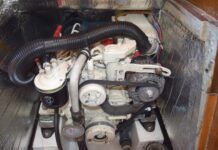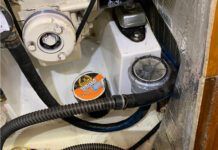I really need to reduce the noise of our engine. Everyone seems to want to line the engine box to dampen noise. That scenario in my situation would be difficult as there is little space to line the interior of the box around the engine. I could line the outside of the engine box. Is this an adequate scenario? Has anyone determined whether this will have the same sound-insulating results?
Don Manness,
Via www.practical-sailor.com
Lining the interior of the engine box is the most common and most effective way to reduce engine noise on a boat. However, you can achieve reasonably good results by covering the outside of the engine box, if that is the only option, according to Matt Devitt at Soundown Corp. (www.soundown.com), a leader in soundproofing materials for boats. The key to a good installation is paying attention to the details like gasketing, filling sound leaks around wire ways, and baffling air intakes; these all help to reduce noise leaks and are things you can likely take care of, even if you don’t have the space to fully insulate the engine box interior. According to Soundown, noise leakage around engine boxes and hatches can contribute up to 5 decibels of unwanted airborne noise on the average boat.
We recommend first replacing the gasketing around the engine box access point with a crush-resistant, closed-cell foam rubber like neoprene, which is also resistant to water and fuels. If thats not a sufficient fix, then move forward with lining the engine box exterior with a composite sound-insulating material like the vinyl-polyether sandwich that Soundown markets. (Be sure to make and use templates when cutting the insulation, and use only recommended adhesives.) Soundowns 2-inch Lead/Foam and 2-inch Lead/Fiberglass, along with Hough Marines Sonovinyl Supreme (www.hamiltonjet.com), were the top picks in our last test of sound-attenuation products (PS, Oct. 1, 1999). Check out that article and our January 2012 blog for more information on effective sound barriers. Also, stay tuned for a test update.
Paint Over Varnish
Im heading south and plan to leave the boat in the Bahamas or Caribbean next summer. I am considering painting over my Bristol Finish varnish with some type of brown paint. After a year or so, Ill remove it to re-show the varnish, etc. Is this idea practical or completely foolish? Any paint recommendations?
Bob Hutchinson
1986 Lord Nelson 41
Bristol, Maine
Covering brightwork with brown paint is not uncommon among low-lattitude cruisers and even high-end yachts planning a stint in the Caribbean. The paint has more pigment than a varnish, so it affords the wood better protection from the sun and slows the varnishs deterioration, and the varnish undercoat offers a hard, protective shell. Painting over varnish also keeps vital glue joints from splitting open.
Start with a good, thick varnish buildup so that you can scuff-sand it (to ensure good adhesion with the enamel) and still have enough varnish that the enamel wont seep into the wood grain as it would porous, unfinished wood. Patch any bare spots or flaws beforehand, and apply a few fresh coats. Wed only recommend using a one- or two-part varnish for this, not a varnish alternative like Interluxs Cetol or a teak oil.
Overcoat the varnish with a one-part alkyd enamel like Pettit EasyPoxy 3510 (www.pettitpaint.com) or one of the top performers in our long-term topside paint test (PS, February 2011), Pettits Z-Spar Marine Enamel and Kirbys Hull and Deck (www.kirbypaint.com) paint.
When you return to more temperate climates, resurrecting the brightwork to its former glory will be a big job, but not as demanding as refinishing a varnish coating that has been allowed to crack and flake away. Sand off the enamel using increasing grits of sandpaper (80-120-150) to expose the underlying varnish. If the varnish is still well adhered, overcoating can follow. If the varnish is showing signs of adhesion failure, then its best scrape, sand, and start over.



































